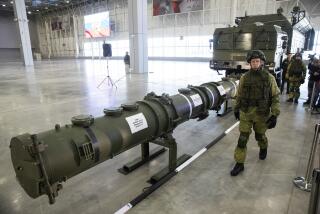Hope Lingers On
In view of recent events it is astonishing to find that a path to serious arms-control negotiations with Moscow may still be open. The Soviets’ new proposal to reduce strategic arms is in some respects more attractive than anything that they have presented before. Some Administration officials are taking it seriously. We hope that they prevail over others who dismiss it as propaganda.
The Administration’s own words and actions have made it hard for anybody to be sure just what its intentions are. Since President Reagan declared the 1979 SALT II treaty dead on May 27, there has been a torrent of confusing and contradictory elaborations--some by the President and his official White House spokesman.
We don’t know what the Administration’s arms-control posture actually is, and we are not sure that Reagan does. But it appears that this country will remain within the limits imposed on strategic launchers by SALT II for a few more months, despite the official repudiation of the treaty, and that the door is open a crack to tacit compliance beyond that time.
That leaves time to ponder and discuss the new Soviet plan that, as Times writer Robert C. Toth reported Tuesday, offers either modest cuts or deep cuts in existing missile forces, depending on how much Reagan will bend on his Strategic Defense Initiative--the “Star Wars” project.
One proposal would limit both nations to 8,000 nuclear warheads on 1,600 missiles or bombers, and confine work on Star Wars to the laboratory under a 15-year extension of the anti-ballistic-missile treaty that strictly limits development and deployment of missile defenses. The new plan would allow larger forces than an earlier version that would cut forces to 1,250 launchers and 6,000 warheads, but would allow no more work at all on Star Wars. But both plans remain on the table at Geneva, which suggests that negotiators could work toward middle ground. For the first time, too, Moscow has dropped its insistence that U.S. fighter-bombers based in Europe and on carriers be included in the ceiling.
Soviet officials are said to be suggesting in Geneva that details are negotiable. Their posture of sweet reason may be cynical and illusory; American diplomats must find out. Certainly a five-to-ten-year moratorium on deployment or advanced developmental testing of missile defense systems should be feasible, considering the technical and financial barriers facing the President’s Strategic Defense Initiative. A moratorium would buy time for more negotiations--and make it safe for both sides to proceed with cuts in offensive nuclear forces.
One problem is that the Administration so far has flatly refused to consider any kind of restraint on its Star Wars program. SDI zealots within the Administration are determined to push Star Wars development efforts beyond the point of no return while Reagan is still in office--and if the 1972 ABM treaty must be violated in the process, so be it. So far the President seems to agree with them.
Under those circumstances there is no hope for agreement at Geneva, and good reason to fear a new and more dangerous acceleration of the arms race that would strengthen anti-American political forces in allied countries. The President still has time to turn things around by whipping into line his hard-lining advisers who plainly and simply oppose arms control. But he doesn’t have forever.
More to Read
Get the L.A. Times Politics newsletter
Deeply reported insights into legislation, politics and policy from Sacramento, Washington and beyond. In your inbox three times per week.
You may occasionally receive promotional content from the Los Angeles Times.










